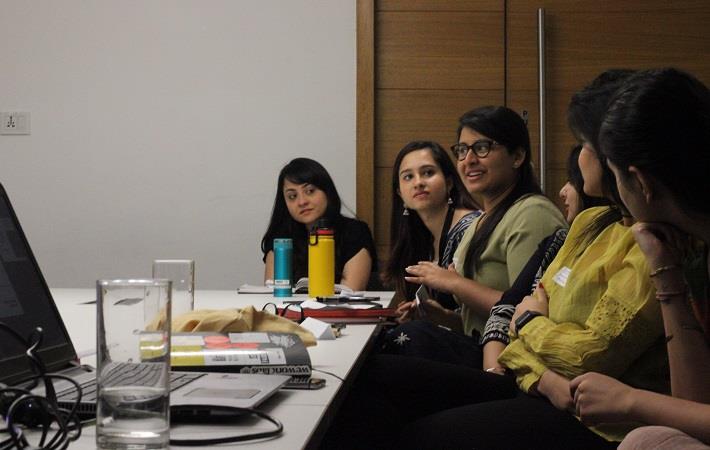Interviews
Artisans deserve more credit
04 May '19
6 min read

Some of the participants at the SUSS seminar
Speakers at a recent seminar about cultural sustainability in India dwelt on the need to protect the intellectual property rights of artisans. Dwijendra Kumar reports.
Are textiles, apparel and related manufacturers aware of factors causing damage to environment through emission of waste materials and chemicals, and are designers giving due credit to artisans and craftsmen for using designs created by them?
How can intellectual property rights (IPRs) of artisans and craftsmen over their work not only be protected, but their contribution duly honoured too? How can brands add shine to their names by employing fair trade practices? Are they using recycled fabrics?
These issues were part of a presentation by Monica Bota-Moisin, a cultural IPR and fashion lawyer, on ‘Cultural Sustainability in India’ at the British Council in New Delhi recently. Her talk was followed by a panel discussion involving stakeholders in the field such as brand owners, government officials holding relevant positions, and also Monica, an expert in the field.
Fashion is the second largest employing segment after agriculture and mainly employs women from a low income background, pointed out Lavanya and Gauri from SUSS, a community and movement that builds awareness and starts conversations around sustainable fashion, and the organisers of the event, while welcoming the guests and setting the tone for the presentations to follow. They added that because of its scope and importance in terms of job creation, the garment industry is a unique opportunity for India to create jobs that are sustainable and fair.
Monica began her presentation by stating that the textiles industry needs to empower artisans by recognising their cultural IPR. Little has been done in India in this regard even though it boasts of a rich heritage in the field. She was quick to add that design plagiarism has been a cause of concern even at the most respectable fashion runways or centres, and designers have been accused of copying others’ designs or those of artisans without giving them due credit.
What rights have been violated is the usual question asked by designers when confronted on cultural IPRs of artisans, Monica added in her presentation. She clarified that these rights are designed to protect artisans, craftsmen and women by entitling them to a form of compensation for their contribution to the survival of cultural heritage by transmitting traditional designs and techniques. Monica gave examples of close coordination between designers and artisans in other parts of the globe—particularly in Romania—and how artisans were made partners as co-creators.
When we are fair to artisans, we are not only adopting fair trade practices, but also promoting cultural values of a community or society as crafts are a part and parcel of it. Through fashion, this cultural knowledge is documented and transferred to others. She stressed on the need for creating a database of embroidery designs and artisans involved, as also forming help groups so that the original creators get due recognition and adequate financial favour in lieu of their hard labour and contribution to culture. “Our mission is to promote and implement benefit-sharing business models for fostering socially and culturally sustainable collaborations between craftspeople and contemporary designers in the fashion business, based on a fair distribution of IPRs and cultural IPRs,” she added.
Monica’s talk was followed by a panel discussion which discussed the issue threadbare covering the role of brand owners as well as the government. Those who participated included Alka Upadhyay, additional secretary, ministry of rural development; Asha Scaria, founder of Swara, a young fashion brand co-creating with artisans in Dungarpur, Rajasthan; and Sonica Sarna of Sonica Sarna Design which engages with vulnerable artisan communities, certified organic fabrics and women’s empowerment programmes to create hi-fashion products for the global marketplace, besides Monica. The session was moderated by Aruna Chawla, a lawyer with an expertise in creative industries.
Monica was the first to speak. Based on her experience of meeting designers and artisans, she vouched for the fact that there is little difference in the way a designer or an artist perceives things and design. The only hitch for artisans is that they do not have exposure to market trends, and the business of fashion. The level-playing effort in the field could be designating artisans as IPR holders of their creations. Artisans should have their own guilds to take up their issues more vocally and seriously with relevant authorities. All these will not come easy unless brand owners are more humane towards genuine concerns of artisans.
Sarna said that she had been engaged in training craftsmen in industrial skills which are important to determine costs and prices of their creations, as also sales through better customer service and negotiations. She said that at her manufacturing units bio-degradable materials are used so that effluents do not contaminate the soil and harm surroundings. According to her, a system of certification in relation to organic and fair trade practices employed by manufacturers should be made mandatory if we are serious about being fair to artisans. If we give due credit to artisans, our products would gain authenticity among buyers and boost sale of products, she concluded.
Scaria, who works with tribal women in some villages in Rajasthan, said that she does encourage artisans to create their own designs instead of mechanically copying those provided by middlemen or manufacturers. She organises tours to metro cities of artisans so as to give them exposure to the functional requirements of customers. She said that she likes to source handwoven or recycled fabrics from cooperatives so that artisans are ultimately benefitted. Further, handwoven and recycled fabrics are crucial to the environment.
Upadhyay noted that there are around 70 lakh registered artisans in India, but their problems are plenty even though efforts are being made towards popularising handicrafts through fairs and by providing them e-platforms to showcase and sell their products. The government is also providing them training in related skills. It is in the interest of artisans and industry that brands step in as a link between artisans and boost the image and sales of their designs and products. Brands should also share good environmental practices with artisans. (WE)
Fibre2Fashion News Desk – India
Popular News
Leave your Comments
Editor’s Pick
































-Ltd..jpg?tr=w-120,h-60,c-at_max,cm-pad_resize,bg-ffffff)





.jpg?tr=w-120,h-60,c-at_max,cm-pad_resize,bg-ffffff)
.jpg?tr=w-120,h-60,c-at_max,cm-pad_resize,bg-ffffff)






